
table of contents
- Caterpillars
- Types from A - D
- Types of E - G
- Types of M - S
- Types from T - Z
- frequently asked Questions
Caterpillars become fascinating butterflies. It is worth looking at them carefully. Many caterpillars have brightly colored patterns, some are noticeably hairy. We present 12 domestic caterpillars with hair.
In a nutshell
- Hairy caterpillar is usually the larva of a butterfly
- Colors to protect against predators are often perfectly adapted to the environment
- bright colors signal danger
- Caution, caterpillar hairs can be dangerous!
Caterpillars
If we come across a caterpillar with hair in the garden or while walking through the forest, it is usually a butterfly caterpillar. Similar to butterflies, plant wasps and beaked flies also develop from caterpillar-like larvae, the so-called anal caterpillars. These differ from caterpillars in the number of free segments between the breast and belly legs. Anal caterpillars have one segment here, whereas butterfly caterpillars have two.
Types from A - D
Maple bark owl (Acronicta aceris)
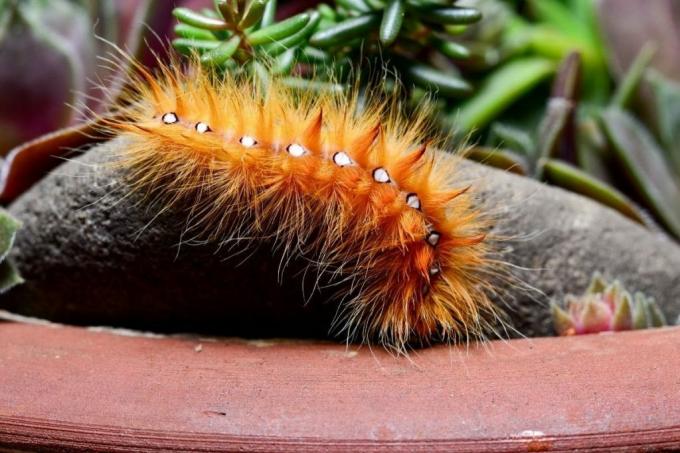
- Order: Owl butterfly (Noctuidae)
- Occurrence: at the edges of the forest, very rare
- Forage plants: sycamore, linden, oak, beech
- Development: one to two generations a year, caterpillars hatch between July and September, overwinter as a pupa
- Length: 35 to 40 millimeters
- Body color: yellow, white, black rimmed spots on the back
- Hairiness: dense yellow hairs, tufts of red hair in the front area
- Butterfly: moth with gray wings
- Endangerment: no
Note: The caterpillar of the maple bark owl curls up in a ring when threatened. The caterpillar with hair then resembles a small ball of fur.
Brown bear (Arctia caja)
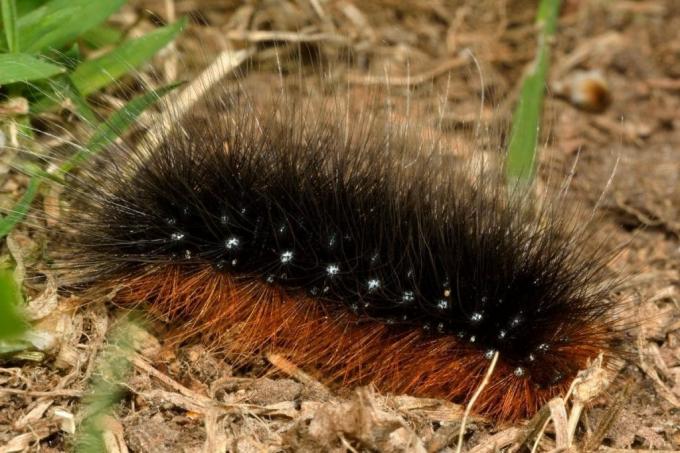
- Family: Bear Moth (Arctiinae)
- Occurrence: forest edges
- Forage plants: sorrel, Nettle, Blackberry
- Development: one generation a year, caterpillars hatch in August, overwinter in the ground, pupate between June and July
- Length: up to 60 millimeters
- Body color: black with white warts
- Hairiness: long-haired, black-brown on the back with gray tips, rust-red on the head
- Butterfly: strong moth with white, black-brown patterned front wings
- Endangerment: yes, especially protected
Beech peg foot (Calliteara pudibunda)

- Family: Bearer moth (Lymantriinae
- Occurrence: deciduous forests, parks, hedges
- Forage plants: hornbeam, red beech, hazel
- Development: one generation a year, caterpillars hatch in July, pupate at the end of October, overwinter as pupae in densely hairy cocoons
- Length: 45 to 50 millimeters
- Body color: whitish or yellowish green to brownish pink, red tufts of hair on the abdomen, black underside
- Hair: thick hair in the same color as the body, light-colored brush on the back
- Butterfly: Moth with light gray wings, forelegs densely hairy
- Endangerment: no
Types of E - G
Oak processionary moth (Thaumetopoea processionea)

- Order: Zahnspinner (Notodontidae)
- Occurrence: everywhere in Germany on oaks and hornbeams
- Forage plants: oaks, hornbeams
- Development: one generation a year, caterpillars hatch at the end of May, are sociable
- Length: 45 to 50 millimeters
- Body color: black-brown back, whitish sides
- Hairiness: warts reddish brown haired, velvety with innumerable stinging hairs covered with reddish mirror spots
- Butterfly: shiny gray fore wings with dark transverse bands, spiky markings on the wing tip, hairy body
- Endangerment: no, dangerous pest
Note: The caterpillars with hair of the oak processionary moth live gregariously in groups. They go single file looking for food together. This peculiarity led to the name "processionary moth".
Common acorn ram (Zygaena filipendulae)

- Family: Ram (Zygaenidae)
- Occurrence: everywhere in Germany at the edges of forests, on rough meadows
- Forage plants: horn clover, thistle, heather, bedstraw, plantain
- Development: one generation a year, caterpillars hatch in July, overwinter on butterfly-flowered plants, pupate on blades of grass between May and June
- Length: 20 to 22 millimeters
- Body color: green-yellow with black spots and black head
- Hairiness: light yellow hairy
- Butterfly: ram with six red spots on the black wings.
- Endangerment: yes
Note: The ram's caterpillars with hair contain poisonous substances. The bright colors warn birds and predators of the danger.
Great Cabbage White butterfly (Pieris brassicae)

- Family: Weißlinge (Pieridae)
- Occurrence: fields, meadows, gardens
- Forage crops: cabbage, cruciferous vegetables, nasturtiums
- Development: two to three generations a year, third generation hibernates as a pupa
- Length: 40 to 45 millimeters
- Body color: young caterpillars light yellow with a brown head, become darker after each moult, older caterpillars are spotted black
- Hairiness: older caterpillars with black hairs
- Butterfly: white butterfly with black spot on the wings
- Endangerment: no, pest
Types of M - S
Moon bird (Phalera bucephala)

- Family: tooth moth (Notodontidae)
- Occurrence: deciduous forests, parks
- Forage plants: linden, beech, laburnum, alder, birch, hazel
- Development: one generation a year, caterpillars hatch in July, initially live socially, overwinter as a pupa
- Length: 55 to 60 millimeters
- Body color: black with orange transverse and white-yellow vertical stripes, black head
- Hairiness: white hairy
- Butterfly: Moth with gray, silver-scaled forewings with a light moon spot, body very hairy
- Endangerment: no
Blackthorn moth (Orgyia antiqua)
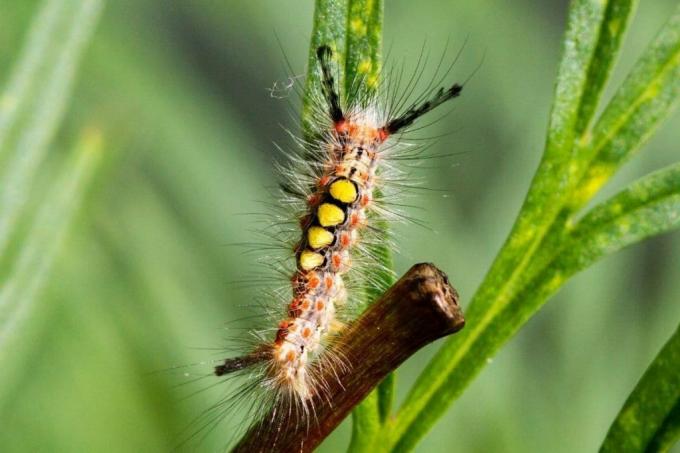
- Family: Bearer moth (Lymantriinae)
- Occurrence: forests, gardens
- Forage plants: blackthorn, hawthorn, sycamore maple
- Development: two generations a year, caterpillars hatch in May and August. Length: 25 to 30 millimeters
- Body color: gray, red and black patterned on the back, red point warts
- Hairiness: four yellowish to brownish tufts of hair on the back, white hairbrushes on the point warts
- Butterfly: males slender with rust-brown wings, females wingless with a thick abdomen
- Endangerment: no
Note: The caterpillar with hair of the sloe moth is one of the most beautiful caterpillars in Central Europe.
Gypsy moth (Lymantria dispar)
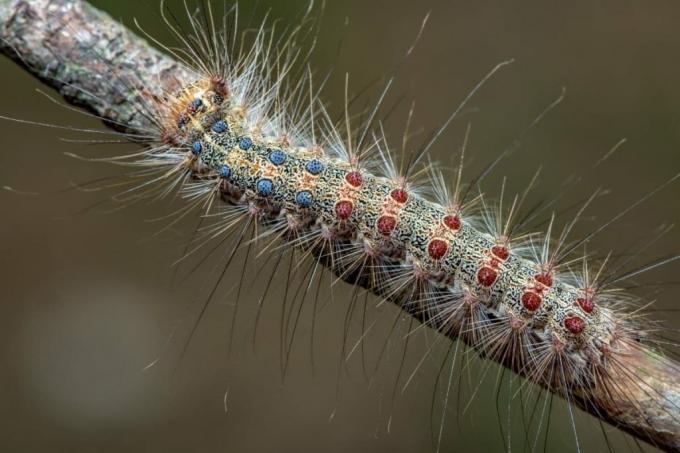
- Order: Bearer moth (Notodontidae)
- Occurrence: deciduous forests, orchards
- Forage plants: oaks, hornbeams
- Development: one generation a year, eggs overwinter, caterpillars hatch in spring
- Length: 40 to 70 millimeters, female caterpillars larger than male
- Body color: gray, finely dotted, blue or red warts
- Hairiness: thick hair on the warts, stinging hairs
- Butterfly: strong moth, males dark brown, females yellowish white, significantly larger than the male
- Endangerment: no, dangerous pest
Types from T - Z
Mourning cloak (Aglais antiopa)
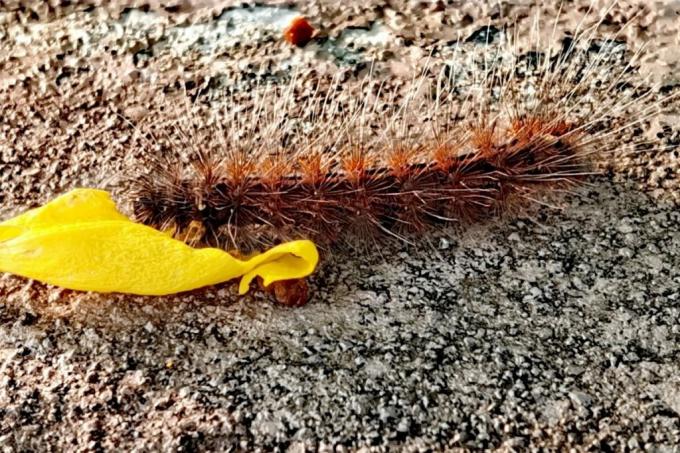
- Family: Edelfalter (Nymphalidae)
- Occurrence: moist deciduous forests
- Forage crops: willow, birch
- Development: one generation a year, caterpillars hatch in June, are sociable, pupate in July
- Length: 50 to 55 millimeters
- Body color: black, white spotted, orange-red spots on the back, black thorns
- Hairiness: fine white hairs
- Butterfly: dark brown with a creamy white, serrated edge of the wing
- Endangerment: yes
White-spot ram (Amata phegea)

- Family: Bear Moth (Arctiinae)
- Occurrence: Northeast Germany, Nahe Valley, Southern Alps
- Forage plants: heather, bedstraw, plantain
- Development: one generation a year, caterpillars hatch in August, overwinter in the ground, pupate between June and July
- Length: up to 30 millimeters
- Body color: black with a rusty red head
- Hairiness: gray-brown, dense tufts of hair on the warts
- Butterfly: strong moth with black-blue, white-spotted fore and hind wings
- Endangerment: yes, especially protected
Milkweed ring moth (Malacosoma castrensis)

- Family: Glucken (Lasiocampidae)
- Occurrence: dry grasslands, sheep pastures
- Forage plants: cypress wolf milk
- Development: one generation a year, caterpillars hatch at the end of April, are sociable, pupate at the end of June
- Length: 55 to 60 millimeters
- Body color: gray-blue, light topline, orange and dark gray longitudinal lines
- Hairiness: laterally hairy
- Butterfly: strong moth with yellow-brown forewings and dark-brown hind wings, body densely hairy
- Endangerment: no
frequently asked Questions
The hairy caterpillar of the oak processionary moth has long red-brown hair on the warts and short cilia. These peel off easily and are spread by the wind. In sensitive people, these can cause severe allergic reactions.
Contact with the hair of the oak processionary caterpillar can lead to redness, nodules and wheals reminiscent of insect bites. In addition, those affected complain of severe itching. Allergy sufferers can react with irritation of the mucous membranes in the mouth and nose, shortness of breath, coughing and asthma. Anyone who notices these symptoms should see a doctor quickly. Change your clothes if you come into contact with a caterpillar with hair. Avoid infested areas.
The massive reproduction of the oak processionary moth can also pose a threat to wild animals and domestic animals. Try to prevent your dog from coming into contact with a caterpillar that has hair while walking.
In addition to the dangerous caterpillars of the oak processionary moth, the hairy caterpillars of the acorn ram, the gypsy moth and the milkweed hawk are poisonous. Never touch a caterpillar with hair!
